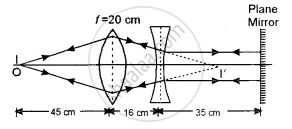Advertisements
Advertisements
प्रश्न
The figure below shows the positions of a point object O, two lenses, a plane mirror and the final image I which coincides with the object. The focal length of the convex lens is 20 cm. Calculate the focal length of the concave lens.

उत्तर
Since the image of the object coincides with the object itself, the rays of light passing through the lens combination strike the mirror normally. The point I’ where the rays of light are converged by the convex lens must be the focus of the concave lens because the emergent rays are parallel to the principal axis. For the convex lens.
u = - 45 cm, f = 20 cm, v = ?
Now, `1/v - 1/u = 1/f`
`1/v + 1/45 = 1/20`
`1/v = 1/20 - 1/45 = ( 9 - 4 )/180 = 5/180`
∴ v = `180/5` = 36 cm
Now, distance between the two lenses is 16 cm.
∴ Focal length of the concave lens = 36 – 16 = 20 cm
Since the lens is concave, f = – 20 cm
APPEARS IN
संबंधित प्रश्न
a) Give two reasons to explain why reflecting telescopes are preferred over refracting type.
Use the mirror equation to show that an object placed between f and 2f of a concave mirror produces a real image beyond 2f.
Use the mirror equation to show that a convex mirror always produces a virtual image independent of the location of the object.
Use the mirror equation to show a convex mirror always produces a virtual image independent of the location of the object ?
Can a plane mirror ever form a real image?
A light ray is incident at an angle of 45° with the normal to a √2 cm thick plate (μ = 2.0). Find the shift in the path of the light as it emerges out from the plate.
A light ray is incident normally on the face AB of a right-angled prism ABC (μ = 1.50) as shown in figure. What is the largest angle ϕ for which the light ray is totally reflected at the surface AC?

A parallel beam of light is allowed to fall on a transparent spherical globe of diameter 30cm and refractive index 1.5. The distance from the centre of the globe at which the beam of light can converge is ______ mm.
The focal length f is related to the radius of curvature r of the spherical convex mirror by ______.
Car B overtakes car A at a relative speed of 40 ms-1. How fast will the image of car B appear to move in the mirror of focal length 10 cm fitted in car A, when car B is 1.9 m away from car A?
